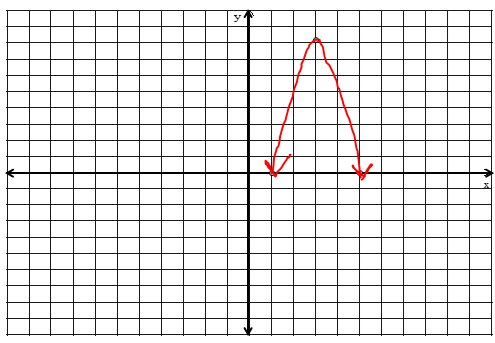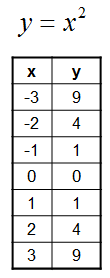When given the equation of a quadratic equation in vertex form and told to graph it, more than one method can be used to do this. The first method is the 4-step process. The 4-step process involves the following steps:
- Graph the base parabola
- Apply the vertical dilation (vertical stretch or compression factor, a) to the base parabola, as a new parabola on the same graph
- Apply the vertical translation to the previous parabola
- Apply the horizontal translation to the previous parabola
Parabolic Note: Steps 3 and 4 can be done in any order
*****
After completing this process, you should have 4 different parabolas, one of which is your final parabola.
For example, if we were to graph the equation y=-2(x+3)^2-2, it would look something like this:
Red represents: y=x^2
Blue represents: y=-2x^2
Black represents: y=-2x^2-2
Green represents: y=-2(x+3)^2-2
 *Scale increases by units of 1
*Scale increases by units of 1
Another, simpler method one can use to graph a parabola in vertex form is the 1-step process, which is:
- Plot your vertex
- Multiply the step pattern of the base parabola (1,3,5,7) by the a value of the equation, and apply it to the parabola
For example, if we were to graph the equation y=2(x+2)^2-4, it would look like this:
 *Scale increases by units of 1
*Scale increases by units of 1
In your grade 10 math career, there may be times when you are given the vertex of a parabola and a point on the parabola (you are either told this, or it is given to you on a graph), and you must determine the equation of the parabola (in vertex form)- in order to graph it. Although this sounds a bit complicated, it is actually quite simple, as you have been given all the information needed to solve the question.
For example, take the graph given above. If we weren’t already given the equation, and were told to find an equation given the vertex (-2,-4) and a point (-1,-2), we would first plug these values into our vertex equation, like so.
y=a(x-h)^2+k
-2=a(-1+2)^2-4
Now, we only have to solve for one variable, a.
Following the rules of BEDMAS, let’s solve what is in the brackets first.
-2=a(1)^2-4
-2=a-4
Now we isolate the variable.
-2+4=a
2=a
Now that we have solved for a, we can create our equation:
y=2(x+2)^2-4
As you can see, as long as we are given the vertex and a point on a parabola (with or without a graph), we can always find the equation.
However, what if we are told to find the equation of a parabola when given a vertex and some translations? Well, we simply apply the skills we learned in the previous lesson, about transformations.
For example, if we are given the vertex (2,5) and are given these translations:
- Vertical stretch by factor of 2
- Reflected on x-axis
- Horizontally translated 4 units to the right
- Vertically translated 2 units down
We would start by modelling the information we do have.
y=a(x-2)^2+5
Now we take the translations, analyze them and what they mean, and plug them into the equation.
A vertical stretch by a factor of 2 means the a value is being affected. The word “stretch” means that the parabola will become narrower, so the a value has to be greater than 1, in this case, it is 2.
y=2(x-2)^2+5
If the graph is reflected on the x-axis, it means that the parabola will go from opening upward, to opening downward- making the a value negative.
y=-2(x-2)^2+5
Since the graph is horizontally translated 5 units to the right, we add 5 to 2, and change the h value to reflect this.
y=-2(x-7)+5
Finally, since the graph is vertically translated 4 units down, we subtract this from the k value, and change the k value to reflect this.
y=-2(x-7)+1
We now have our new equation.














